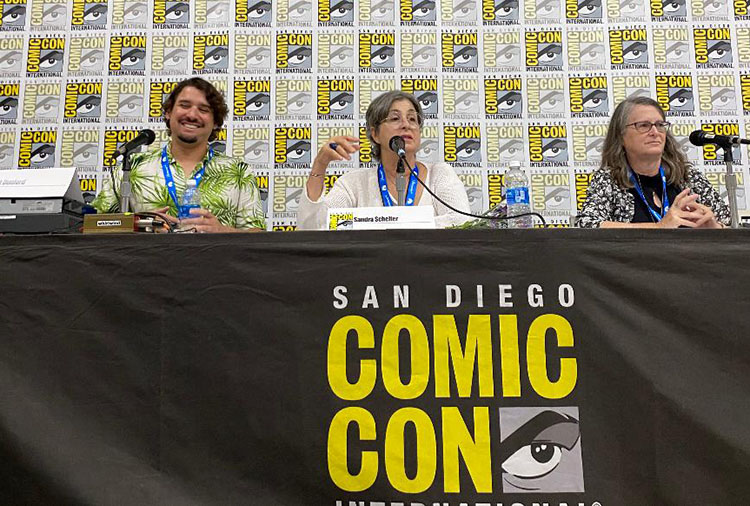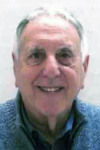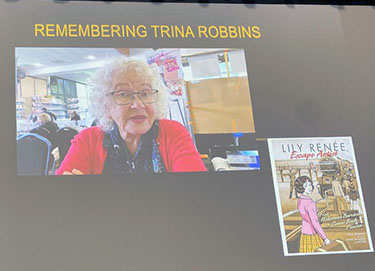
By Donald H. Harrison

SAN DIEGO – Graphic artist Trina Robbins, who died earlier this year, was saluted by Comic-Con panel members who recalled Robbins’ salute to Lilly Renée, another woman pioneer in the comic book industry. Both Jewish women had a hand in World War II comic book stories in which the evil Nazis were given their comeuppance.
The tribute to Robbins dovetailed with the announced topic of Thursday’s panel, which was “Art from the Holocaust.” Sandra Scheller, the curator of a Holocaust exhibit that has been making the rounds of local libraries, was the moderator. She was joined by Marcia Tatz Wollner, western states regional director of the March for the Living, and graphic artist Matt Dunford, who has a sustaining interest in World War II history.

Eventually, she ran away from that situation, hoping to find work as an artist, having learned to draw from a very early age. Meanwhile, however, her parents had escaped Nazi Austria to New York City. After a brief stay in a local jail – having been tabbed an “undesirable” alien – Lily voyaged to New York, where her parents now lived in reduced circumstances. Lily found work in the comic book industry, drawing and inking a variety of titles, including Senorita Rio, a heroine who engaged in espionage work against the Nazi Germans.
Wollner said that when people think of women caught up in the Holocaust, they first think of Anne Frank. There are others with compelling stories, including Charlotte Salomon, who drew 769 autobiographical portraits before she was murdered in Auschwitz in 1944.
The panelists turned to the stories of Roza Robota, Ala Gertner, Ester Wajcblum, and Regina Safirsztajn, four women who smuggled gunpowder to members of the sonderkommando at the Auschwitz-Birkenau Concentration Camps. The gunpowder came from a nearby munitions factory where prisoners were forced to do slave labor. The sonderkommando worked at the crematoria where bodies of Holocaust victims were burned after they had been gassed.
On Oct. 6, 1944, the sonderkommando blew up crematorium No. 3. The Gestapo tortured the four women to learn the identities of their suppliers, but the women stayed mum. On their way to the gallows, where they were hanged, the women reportedly shouted “Chazak V’amatz,” strength and courage.
Scheller, the panel moderator, said her own mother, Ruth Goldschmiedova Sax, worked in a munitions factory making bullets. She said her mother, at great risk to her life, scored the bullets with sand, hoping that would modify their trajectories — a smaller, yet significant, act of sabotage.
Sax, who later settled in Chula Vista, was the inspiration for RUTH: Remember Us the Holocaust exhibit, which told the stories of Holocaust survivors who settled in San Diego County and the lives they made for themselves here. The exhibit started at the main library in Chula Vista, and later moved to the library at Rancho San Diego. It is now being readied for showing at the La Jolla Library in January. Scheller announced Thursday that a spin off exhibit, focusing on the life of her late mother, will be shown at the Coronado Public Library.
Panel members then switched topics, projecting images of antisemitic postcards and graphics from the late 19th and early 20th centuries. Dunford said a common theme was to dehumanize Jews, utilizing common tropes. Jews were drawn with big noses, ugly visages, and pictured as dirty and greedy with aspirations to take over the world.
Not wanting to leave the audience with the impression that all graphic depictions of Jews were negative and antagonistic, Dunford told of Jacob Kurtzberg, better known to his fans as Jack Kirby, the inventor of the comic book hero Captain America. The premier issue of Captain America in March 1941 showed the superhero punching Nazi fuehrer Adolf Hitler in the face. Kirby went on to become the genius behind Marvel Comics
*
Donald H. Harrison is publisher and editor of San Diego Jewish World.
Thank you for introducing me to Holocaust art work and stories beyond Maus or Anne Frank. I am eager to see the exhibition in La Jolla.